Panzerdraisine (1942-44)
 Nazi Germany - c80 draisines.
Nazi Germany - c80 draisines.
The wide family of German armoured draisines
Tank trolleys or Draisines of the Wehrmacht where needed, as operations on the Eastern Front bogged down. Now with a more static frontline, communications lines needed to be protected by late 1942. Soon it became more urgent in 1943 to devise a solution as gradually partisan multiplied more ambitious operations, notably in the Balkans, Greece and Yugoslavia. Alonsgide regular tanks placed on railway cars and able to dismount, the Heer expressed the need for independent draisines such as those fielded by Poland and Czechoslovakia among others.Supplies became absolutely vital in 1942-43 and to keep a well-functioning supply system meeting its quantitative requirements, the railway connections needed to be monitored and protected against partisan attacks. For thios was designed a serie of armoured draisines (panzerdraisinen) for the Wehrmacht. As required in late 1942, they needed to highly mobile. The frist to come put were the light reconnaissance platoons (le.Sp. 301 to 304) and later heavy reconnaissance platoons (see Col. 301 to 210). These draisines soon became just as important as main armored trains or auxiliary railway armored trains. They were declined, often in common railway car basis, to railway protection and command trains, and declind into multiple variants, the more fearsome of these being the railway tank destroyers (Panzerjäger).
The backbone of these light and heavy reconnaissance train units were their armored draisines declined organically into infantry, artillery, radio and command cars, a completely new development of the German armaments industry at the time. There was no such thing as armoured draisines in german service prior to 1942. These vehicles had their own propulsion and coupling system to allowed other self-propelled units to be joined together, the manoeuver made from the protected inside.
The infantry cars were the basic versions, used to transport infantrymen with four turret machine guns for fire support in two casemates fore and aft. The artillery car was created by combining and infantry car and a heavier draisine equipped with a Panzer III Ausf. N. turret. It was the trusted 7.5cm KwK L/24, same used in early Panzer IV variants. The radio and command cars had a central casemates (also with MGs) and a distinctive bedframe antenna on top.
The state of German railway assets in 1939
While preparing for the Second World War, Germany wanted seven standardized armored trains in ordee to patrol its main communication lines, especially dueing an advance and afterwards in occupied territories. Europe shares the same gauge until Russia started and so this was a sound move. With the annexation of Austria, occupation of Czechoslovakia and invasion and occupation of Poland German armored trains proved very useful. Typical German armored train had 12-18 railroad cars plus their armored locomotives with coal tenders often in the middle for extra protection.As part of their core composition were found command cars, main and reserve command post as well as "dismounted infantry" cars, and artillery car armed generally with surplus WWI guns or howitzers, 7.5cm or 10.5cm. There were also FLAK cars armed with 2.0cm AA guns, and 2-3 tank in railcars for infantry support once dismounted, either to pursue attackers or push a transverse reconnaissancein force of the surrounding area. At last there was the logistical flatcars with all material need for rail repair or mine clearing equipment.
In April 1941 dueing the invasion of Yugoslavia, Armored trains No. 23 and No. 24 saw action and stayed, taking part in many anti-Partisan patrols in Serbia, especially in the winter 1941/42. After the uprising in Serbia was crushed, these trains patrolled on the Zagreb-Belgrade road. More trains were ordered and in the winter 1944/45 nearly half of all German armored trains were fighting on the eastern front. The Zagreb-Belgrade-Salonika railway used by retreating troops from Greece, Bulgaria, Romania and Yugoslavia saw the Eisenbahn-Panzerzüge adminstration keeping in operation No. 4, 6, 23, 64, 65, 73. There were Heavy Reconnaissance Trains (schweren Spahzüge) as well, the 201, 202, 203, 204 and Light Reconnaissance Trains (leichte Spahzüge): 301, 302, 303, 304 as well as Command Train (Kommandozüge), just one (No. I). There were also track Protection Trains (Streckenschützzüge) called 'Max' and 'Werner' as well as the Protection cars No. 30, 31, 32, 33, 34, 35 and 38.
Armored trains No. 301 was the first destroyed in Kraljevo by November 1944, No. 302 in Kosovo Polje (November 12)and No. 201 in Čačincima (April 15) in 1945. Panzerzüge 6 was destroyed on October 1st, 1944 and at Celje and Dravograd (Slovenian-Austrian border) in May 1945, 12 armored trains surrendered, some reused by Yugoslavia post-war. Probably among the most interesting ones were the 200 and 300 series armoured trains, for which were developed new type of armored railroad car draisines which could be detached the main train and perform reconnaissances, connected and disconnected from inside.
The 200 series Armored trains were part of the Heavy Reconnaissance Trains or "schweren Spahzüge" and were generally composed of the following:
- Two command railroad car (center)
- Four multi purpose infantry railcars
- Two artillery car with 75 or 105 mm gun turrets
- Two FLAK cars with 20 mm (Flakvierling or quad in 1944-45)
- Two tank railcars, enabling their unloading, with a Somua, FT-17 or Pz.38(t)
- Two to four utility spares/repair/supply flatcars.
The Armored trains of the 300 series were the "Light Reconnaissace Trains" or leichte Spahzüge, composed of just four command car and six multi purpose railcars partly escort of individual freight or passenger trains at their end. They were a less "offensive" and more defensive type.
Heavy reconnaissance platoons:
The schweren Spähzüge were formed September 15, 1943 and comprising:- 1x Kommandantenwagen (commander's car)
- Zugtruppführerwagen (Infanterie) (platoon driver's car)
- 2xInfanteriewagen (troop transports)
- 1x Pionierwagen (engineering vehicle)
- 1x Zugtruppführerwagen Artillerie (artillery platoon command car)
- 4x Artilleriewagen (artillery wagons)
- 2x Flakwagen (anti-aircraft cars, 2cm Flakvierling)
- 2x Panzerträgerwagen mit Skoda Pz 38 (t)(Panzer 38 (t) on flatcar)
- 1 Spähpanzer (Schienepanzer) Panhard 204 (Railway Reconnaissance Car)
- 2x command cars
- 2x infantry wagons
- 2x pioneer wagons
- 2x artillery wagons
- 2x Flakvierling flat cars
- 2x Skoda Pz 38 (t) flatcars
- 2x supply flatcars (Abstoßwagen mit u.a. Gleisbaumaterial) with spare tracks and repair equipments
- 1x Dampflok (steam locomotive, when gasoline was in short supply)
- 2x gewöhnliche Waggons (middle utility flatcars)
- 4x multi-purpose infantry wagons
- 2x artillery wagons
- 2x FLAK cars
- 2x flatcars with Somua or Pz 38 (t)
- 2-4x additional flat cars
Hiwever as the war progressed, this nice scheme of armoured train was cut down to the following:
In the Balkans, such train was observed:
Light reconnaissance platoons:
The leichten Spähzüge consisted of four command cars, six multi-purpose cars. They escorted supply/passenger trains. It obviously lacked AA fire, artillery support or even antitank defense.leichte Schienenpanzer le.SP (Panzersicherungswagen)
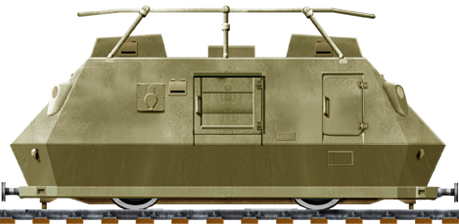 One type was the Le.Sp light reconnaissance armored railcar. This model was based on a Steyr K2670 draisine covered with light armored plates (resistant to small arms fire and up to 14.5 mm against 20 mm rounds) and weighting 7.5 t, and 9.5 tons fully loaded. These were draisines in the sense they were fully motorized and considered like proper "armored cars" on rails. They were produced from 1943, and able to operate independently or in series 300 armored trains.
One type was the Le.Sp light reconnaissance armored railcar. This model was based on a Steyr K2670 draisine covered with light armored plates (resistant to small arms fire and up to 14.5 mm against 20 mm rounds) and weighting 7.5 t, and 9.5 tons fully loaded. These were draisines in the sense they were fully motorized and considered like proper "armored cars" on rails. They were produced from 1943, and able to operate independently or in series 300 armored trains.
They were crewed by 4 to 8 men, with from eight to six MG.34 machine guns as main armament. It measured 5,69 m long for 2,52 m side, and with aerial 2,53 m tall (2.27 without). Maximum speed was 60 km/h and range - 400 km on 2-axle. The engine was an air-cooled 3.5 l V8 Steyr 70 HP mounted centrally in the chassis. They had two observation posts fore and aft, each with a small hatch, four armoured shutters with vision slits, sloped front and rear, sides, two access doors, six MG ports (two front, two aft, two sides) and a radio set to report local situation, and the associated bedframe antenna over the roof. They had two bogies and two connection ports. They also had eight covered air intakes on the left side. The six MG ports generally shared only four 7.92mm MG-34 machine guns. The Füg aerial was for short-range communication, with a set comparable to the Sd.Kfz.251/6 Ausf.B mittlere Funkpanzerwagen.
The vehicle was designed by the Austrian works Steyr-Daimler-Puch AG in 1943 (c40 built). Used in Leichte Spähzug series 300 and semi-independent units, having up to ten of these draisines each, used mainly for anti-partisan service in Balkans. Light axle pressure of 4.7 t enabled use of degraded tracks and they were notably deployed with le. Sp. 301, 302, 303 and 304. One was found in 1945 in Poland and was captured and reused postwar by Polish forces in the SOK armoured train, late 1940s used notably in Operation "Wisla", in service until 1950s and with the Internal Security Corps.
Leichter Panzer Draisine Kanonenwagen
First model with two-bogies base. The Panzer Draisine was a self propelled heavy railway unit armed with a short barrel gun mount on a Panzer III Ausf M turret, and armed with up to five machine guns: The turret coaxial, two on either side in hatch mounted pistol ports (the doors and hatches were interverted from left to right). The base version had slab sides armour, slightly sloped up and down on both sides but much more fore and aft. There were smaller vision hatches, two on either sides, two on the forward plate and two on the back plate.Little info is available on the powered railcar built as a base for the frame and armour cover, likely just enougb to resist small arms fire and splinter. The central section was reinforced by a cage that acted as support for the ring mount and Panzer III turret. In it took place the commander and his own panormaic hatch aft and center, the gunner and loader on either side of the gun. Being from an Ausf M, it carried the same number of ready rounds in the turrets, with more in the hull below. The crew could amount six men, including the turret crew (3) and two MG-gunners plus a mechanic. The tank commander was likely the draisine commander as well.
No info on the speed and autonomy of these vehicles (yet). They were a more odular, flexible basis, to be operated alone or joint in composite "trains" counting also an infantry draisine, command, engineering and supply vehicles, for vulnerable sections of the railway, and use against partisans on rear lines from the frontline in Russia to back in the Balkans. They were also used in Italy from 1943 to 1945.
Schwere Panzerdraisine (1945)
Same as above, three heavier, twin axles bogies and longer hull but same hull design, created to support Panzer IV turrets. The Kanonenwagen Heavier variant used Mark B/C turm. Same basic hull than the Leichter Pz.Draisine K.Wagen but with twin bogies. The tank-hunter variant used the Panzer IV ausf J turret with the long barrel 75 mm guns, and was called the Schwere Panzerspähwagen Ausf J pr Panzerjäger ausf J. There were also alternative variants on two and four axles bogies with a different armour design, with tiered faces and back upper plates.Schwerer Spähzug (s.Sp.) Artilleriewagen
Another type was the Schwerer Spähzug (s.Sp.) Artilleriewagen, self-propelled draisine, railcar and railway wagon, equipped with a 7.5 cm KwK 37 L/24 low-velocity gun in a PzKpfw III Ausf N turret. It fought in Germany by 1944. The Artilleriewagen combined a standard Panzer Draisine hull, at first created for a command and infantry model, reinforced to carry the turret from a Panzer III Ausf. N. The latter mounted the 7.5cm KwK L/24 firing either high-explosive and if needed, a few AP shells in bad enounters. As partisans lacked armor, it was often enough to break an ambush. The vehicle was likely to carry a few infantry as well and in any case, had four machine guns posts, sometilme with just two MG.34 or 42 that were just mounted on the ports facing the attack.Closely related: Steyr Armoured Trolleys
Steyr of Austria was directed by the Wehrmacht to built a serie of reconnaissance draines, lightly armed, called the L2670 leichtes panzertriebwagen.The light armoured reconnaissance trains Panzerzug (le.Sp) 301 to 304 created on 16 September 1943 were sent to the Balkans. No 301 operated in March and April in Serbia in the Ujse-Raska region and was destroyed at the end of the year. No 303 would be captured at the end of the war and No 304 was destroyed. To the best of our knowledge only one of these trolleys survives, in Trieste, being the one used by the British in their zone.
Steyr built the trolleys which would form the heavy reconnaissance armoured trains Eisenbahn-Panzerzug (s.Sp) Nos 201 to 210 on the mechanical base (chassis and motor) of the le.Sp. Train PZ (s.Sp) 201 was created on 5 January 1944 then was sent to the Balkans, where it would be captured at the end of the war. Nos 202, 203 and 204 became operational on 10 January 1944, 21 February 1944 and 23 March 1944 respectively, and were also sent to the Balkans. Nos 205 to 208 were built between April and June 1944. The last two in the series were not completed, at least one of them being captured at Millowitz in April 1945.
Note: To be followed by more updates. Portal Page.
Others
Panzertriebwagen No. 16
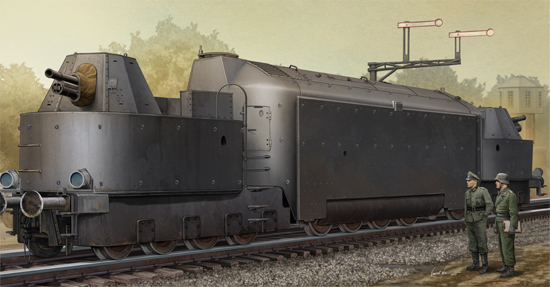
Panzertriebwagen No. 16 (PO PzTrWg 16 or PT 16) - German heavy armored motor car , powered by a diesel engine with an output of 550 HP driven by a Voith hydraulic transmission, was produced by the German company Berliner Maschinenbau-Gesellschaft Actien vormals L. Schwartzkopff in 1942. It is based on type WR 550 D14 armored locomotive, then fully encased in armor and equipped with two additional crew members for the armored artillery positions on the two ends of the unit. They were initially armed with two 20 mmanti-aircraft gun - 2 cm Flakvierling 38 - but were modified by the crew members. The armament were replaced with Russian 76.2 mm FK 295/1 artillery cannon (as found on type BP42 armored trains). The thickness of the armor of Panzertriebwagen No. 16 ranged from 31 to84 mm. This vehicle was the heaviest single-rail armored vehicle. Only one copy was built, which fought on the Eastern Front.
In 1943, PzTrWg 16 was a reserve weapon, which was used to patrol areas threatened by the guerrillas. In the spring and summer of 1944 it was deployed to Army Group Centre. It saw action in the battles of Rawa Ruska andLublin, then withdrawn toRadomafter moving the front to the west. From August to September 1944, it ran the stretch of Kielce, patrolling the railway lines to Krakow, Skarzysko and Radom. In April 1945 PzTrWg 16 took part in the battles of Neuruppin. On 1-2 May 1945, it was captured intact in Neustadt (Dosse).
Galerie

Panzersicherungswagen type Steyr K 2670 or Le.Sp, Balkans 1942
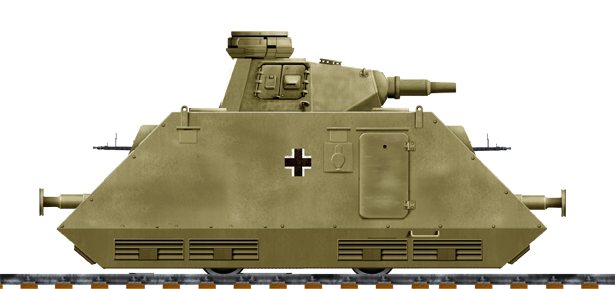
Panzer Draisine with Panzer III Ausf M turret, Italy 1943
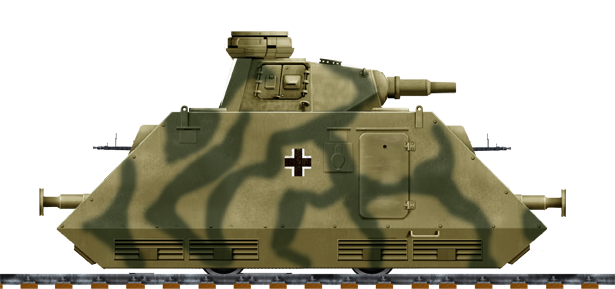
Same, camouflaged, Greece 1943.
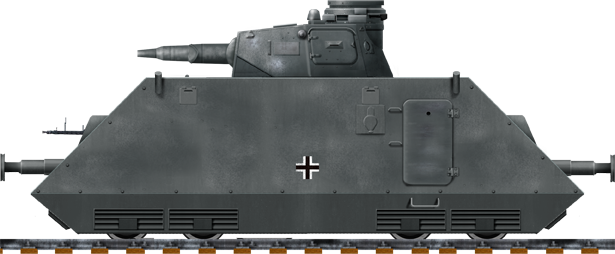
Experimental early Schwere Panzer draisine with a Panzer IV Ausf C turret, 1942
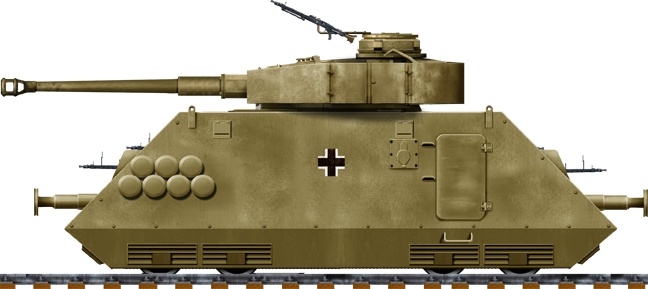
Schwere Panzerspähwagen Ausf J

Ovrview of the artillerie Draisine

Schwerer Spähzug (s.Sp.) Artilleriewagen in winter (model kit art)

schweren Spähzüge

Coupled infantry, command and artillery draisines

Examples (top) or a command and artilelry draisine (all:pinterest)
Sources
bp42-44 on panzerbaer.deSchwerer Panzerspähwagen (Artilleriewagen) fingolfen.tripod.com
Schwerer Spähzug s.Sp. (1944)
inet.hr/steelpanthers
pzdraisine on panzerbaer.de
weaponsandwarfare.com
SOK, Panzersicherungswagen in Polish service postwar
- Baldwin Railroad battery 1861
- No 6 Garrison Arm. Train 1894
- Ladysmith Train 1899
- Crewe Works 1915 coastal train
- French mobile artillery battery (1914)
- Royal Navy armoured Train 1914
- Regia Marina Arm. Trains 1915-18
- Ajmer arm. trains 1916
- Hungarian MAVAG train
- German Panzerzug Ost (1916)
- Bolshevik Armored Tram 1917
- Finnish Arm. Train (1918)
- Zaamurets (Orlík, BP-4, Lenin)
- Khunkhuz
- General Annenkov
- Yenisei
- Amur
- Terek
- Don
- Dywizja Syberyjska trains 1918
- Kozak
- Piłsudczyk
- PP3
- Gromobój
- Pionier
- Śmiały
- Lis-Kula
- Hallerczyk
- Stefan Batory
- Generał Iwaszkiewicz
- Chrobry
- Wilk
- Danuta
- Poznańczyk
- Kaniów
- Zawisza Czarny
- Zagończyk
- Paderewski
- Mściciel
- Reduta Ordona
- Huragan
- Podhalanin
- Bartosz Głowacki
- Pierwszy Marszałek
- Groźny
- Śmierć
- Śmigły
- Stefan Czarniecki
- Generał Sosnkowski
- Putilov armoured trains
- Izhorskiy Armored Train
- Czechoslovak Legion Trains
- Estonian Trains
- Lithuanian Trains
- Zhang Zongchang Train
- Danuta
- Poznańczyk
- Generał Sosnkowski
- Paderewski
- Śmierć
- Pierwszy Marszałek
- Piłsudczyk
- Śmiały
- Groźny
- Bartosz Głowacki
- Smok Kaszubski
- Drezyna R
- Drezyna TK/TKS
- UK dywizjon Trains
- SOK Draisines 1945
- Arm. draisine Crochat
- Austro-Daimler Draisine
- Armoured draisine Tatra T18
- MBV-2 Rail cruiser
- D-2 Draisine (MBV-31)
- D-37 Draisines
- Krasnaja Zvezda (KZ-1)
- D-3 Draisines
- BTD heavy Draisines (5)
- CB-1 Draisines
- DT-45 Draisines
- BD-41 Draisines (12)
- BA-I-Zhd Railcar
- BA-6ZhD Railcar
- BA-20ZhD Railcar
- BA-10Zhd Railcar
- VS-60 Train/Wagon
- BP-35L/H Train
- NKPS-42/Wagon Train (40)
- PL-35 Arty Wagon
- PL-37 Arty Wagon
- PT-35 Arty Wagon
- KV-1 Arty Wagon
- Crimean 76mm univ. Wagon
- "Tank" Wagon
- BP-42 Train/PL-42 Wagon (10)
- BP-43 Train/Wagon (54)
- 7.62mm Maxim SPU-BP Flak wagon (28)
- 37mm PVO-4 FLAK Wagon (120)
- OB-3 Light Wagon
- 27th Div armoured Trains
- 29th Div armoured Trains
- 48th Arm. Div armoured Trains
- "Stalinets" armoured Train
- "Mir Jafar Bagirov" armoured Train
- "Kozma Minin" armoured Train
- "Dzerzhinets" armoured Train
- "Za Rodinu!" armoured Train
- "Kolomensky Rabochy" armoured Train
- Zenitnyy (AA) armoured Trains
- Goering's Asien
- BP42 armoured train (full)
- BP44 armoured train (full)
- Panzerjägerwagen BP44
- BR 52, Steyr Schwerer Schienen Panzer
- Schwerer gustav Train
- P204(f) rail tank
- Schienenkampfwagen SK 1
- Schwerer Spähzug (s.Sp.) Artilleriewagen
- LeichteSchienenkampfwagen 43
- Zeppelin Panzer Draisine
- Panzertriebwagen N17
- Panzertriebwagen N16
- Panzer Draisine Funkwagen
- Panzerdraisine/Pz.III turm
- Panzerdraisine/Pz.IV turm
- Panzer Draisine Le.Sp.
- Panzer Draisine Flakvierling
- S.Panzer Draisine Kugelblitz
- L2670 leichtes panzertriebwagen
- AB Ferroviana
- Littorina OM 36
- LiBli 42
- Type K2 Steam Locomotive No.134
- Type C56 Steam Locomotive No.31
- Type 90 240 mm Railway Cannon (Futtsu Cannon)
- Type 91 Broad-gauge Railroad Tractor (So-Mo)
- Type 94 Armoured Train
- Type 95 Armoured Railroad Car (So-Ki)
- Type 98 Railroad Tractor
- Type 100 Railroad Tractor
- Type 2598 Railroad Car
- Rinji Soko Ressha 1933
- 1940 coastal defence Trains
- Royal Armoured Corps Trains
- Romney, Hythe and Dymchurch Train
- Malaya Arm. train 1942
- 101-104. sz. páncélvonat
- Finnish Winter War Train
- Croatian Armored Train
- Can. Aleutian No.1 Armoured Train
- Slovak resistance armoured train
- Iraqi armoured train (1941)
- Polish 1945-55 trains
- Arm. train La Rafale 1948
- Tren Blindado 1958
- Panser Rel V16 (1955)
- White Train 1957-87
- RT-23 Molodets ballistic wagon
- Trans-Siberian Arm. Train 1970
- North Korean Arm. Train
- Krajina express 1990
- Volga (2022)
- Baikal (2022)
19th Cent. Trains
WW1 Armored Trains
 Poland
Poland
Interwar Armored Trains
WW2 Armored Trains
 France
France
 Austria
Austria
 Czechoslovakia
Czechoslovakia
 USSR
USSR
 Nazi Germany
Nazi Germany
 Italy
Italy
 IJA
IJA
 UK
UK
 Others
Others
☢ Cold war Armored Trains
References
blog.railwaymuseum.org.ukarmedconflicts.com Russian Trains
warhistoryonline.com
feldgrau.com ww2 german trains
cuttersguide.com
wikipedia.org/wiki/Armoured_trains_of_Poland
derela.pl/drais
derela.pl/tatra.htm